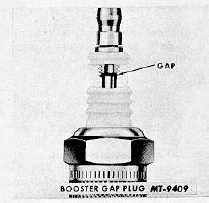|
| |
TRUCK SERVICE MANUAL
TM 5-4210-230-14&P-1
ELECTRICAL
INSTALLATION
When installing spark plugs, always be sure gasket seats and
threads are clean.
Using a torque wrench, tighten plugs to 2830 ft. lbs.
BOOSTER GAP PLUG
For the past several years auxiliary gap (Booster Gap)
spark plugs have been used in certain IH engines,
Fig. 19
Prior to IH approval, the Booster Gap design was
thoroughly tested and evaluated, at which time their anti-
fouling characteristics were firmly established.
What is a Booster Gap plug?
This plug has an internal air gap between the center electrode
and the terminal stud.
How do they work?
Most servicemen know that misfire will occur when a
conventional spark plug is fouled. As the coil attempts to build
up voltage on the "dirty" firing end, it "sees" an easier path to
ground over the deposits. This short circuit prevents normal
voltage buildup. The Booster Gap, however, isolates the coil
from the fouling deposits, allowing near normal voltage build-
up. The instant the Booster Gap sparks, sufficient voltage
appears across the firing gap and normal ignition results.
When you remove a plug wire from a fouled plug and let the
spark jump from the cable to the plug terminal to make the
plug fire, you are using this same Booster Gap principle.
Where are Booster Gap plugs used?
Maximum benefit from this design is obtained in
engines that operate over a wide load and speed range. For
example, a heat range cool enough for highway service will
have better fouling protection during stop-start city delivery
service with the Booster Gap.
Furthermore, the Booster Gap has been instrumental in
reducing the complaints of "break-in fouling" in new engines.
In many cases misfire due to oil fouling in older
engines can be relieved simply by using the recommended
heat range plug incorporating a Booster Gap.
A cure-all?
Not
at
all.
Booster
Gap
plugs
used
where
recommended and applicable to help solve fouling problems
will give excellent results. However, the need for the correct
selection of plugs in the proper heat range based on type of
vehicle operation is important.
Where more severe conditions of fouling as a result of
light service application or break-in fouling on engines occurs,
the alternate recommended hotter type plug with Booster Gap
should be used.
Voltage Requirements
While nominal in amount, the Booster Gap does
require more voltage initially than conventional spark plugs.
This higher requirement diminishes, however, after several
thousand miles of use.
Most any ignition system has more than adequate
reserve to supply the bit of extra voltage requirement; if you
experience misfiring with Booster Gap plugs and not with
conventional plugs, chances are the ignition system is
marginal.
It should also be pointed out that Booster Gap plugs
are not resistor plugs. If radio interference is a problem on
older vehicles having nonresistor ignition cables, it may be
necessary to install resistance leads (cables). Booster Gap
plugs may be used in conjunction with resistance-type ignition
cables to obtain interference suppression and still obtain the
added benefits of the Booster Gap. This is the combination
that is recommended on all gasoline powered motor truck
engines.
CTS-2016-J Page 8
PRINTED IN UNITED STATES OF AMERICA
|

